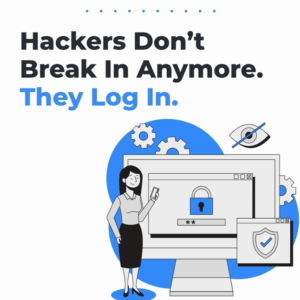These days, cybercriminals don’t need to pick the lock or smash a window—they just need your password. 
And for too many small and midsize businesses, that’s exactly how breaches begin.
It’s called an identity-based attack, and it’s now the #1 way hackers get inside company networks. Instead of brute force, they use stolen credentials, phishing emails, or fake login prompts. They rely on human error—because it works.
Last year alone, a major cybersecurity firm found that 67% of serious breaches started with compromised logins. Big-name companies like MGM and Caesars fell victim to this tactic. If it can happen to a multi-billion-dollar enterprise, it can absolutely happen to a 50-person law firm or a healthcare clinic with a part-time IT guy.
The New Playbook: Trick, Click, and Slip
Here’s how these attacks usually go down:
- Phishing emails with lookalike login pages trick employees into handing over their credentials.
- SIM swapping lets hackers steal text messages meant for two-factor authentication.
- MFA fatigue attacks flood users with push notifications until someone accidentally approves a login.
- Vendor backdoors—like call centers or IT contractors—get compromised, giving hackers indirect access to your system.
It’s not just about firewalls anymore. It’s about who holds the keys—and how easily they can be swiped.
How To Keep the Bad Guys Out
The good news? You don’t need to be a cybersecurity expert to lock things down. Just a few smart moves can make a world of difference:
🔐 Use Multifactor Authentication (MFA)
This is your “second lock.” But don’t rely on texts—go with app-based MFA (like Microsoft Authenticator or Duo) or a hardware key.
📚 Train Your Team to Spot the Bait
If your people can’t recognize a fake login request, your entire system is at risk. Invest in basic cybersecurity awareness training—it’s one of the highest-ROI moves you can make.
🎛 Control Who Has Access to What
The fewer doors someone can open, the less damage a stolen key can do. Make sure employees only have access to the tools and files they actually use.
🔑 Go Passwordless (Or at Least Smarter)
Encourage the use of password managers—or better yet, shift to biometrics and security keys that don’t rely on passwords at all.
You Don’t Have to Do This Alone
The truth is, most small business leaders don’t want to think about cyber threats until it’s too late. But the cost of inaction? That’s steep.
We help businesses like yours put real protections in place—without disrupting your day-to-day.
Want to know if your company is vulnerable? Let’s take a look together.
Book a quick discovery call here → https://go.appointmentcore.com/AnthonyPorch
